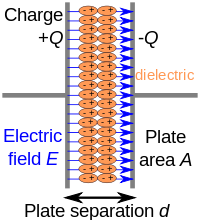
Photo from wikipedia
We present a detailed dielectric response of EuTiO3 to identify the role of Eu3+, Ti3+ ions, and oxygen vacancies in the generation of hopping conduction by varying oxygen stoichiometry. The… Click to show full abstract
We present a detailed dielectric response of EuTiO3 to identify the role of Eu3+, Ti3+ ions, and oxygen vacancies in the generation of hopping conduction by varying oxygen stoichiometry. The dielectric response clearly reveals a transition from single relaxation to multiple relaxation mechanisms (excluding grain boundary contribution) as a function of a decrease in oxygen content. Systematic evaluation of dielectric and electric responses with the aid of magnetic measurements has been utilized to differentiate between Eu3+ doped EuTiO3 and EuTiO3-δ compounds in least and moderate reducing conditions. A rise in AC conductivity correlates well with the onset temperature of relaxation mechanisms, and the corresponding activation energies calculated through the Arrhenius law indicate that the observed mechanisms are thermally activated charge carrier hopping between Ti ions present in multiple valent states. A schematic model is presented for EuTiO3, and the possible conduction mechanisms are determined considering the Eu2+/Eu3+, Ti3+/Ti4+, and oxygen vacancy defects. The presented model fits well with the experimental results and implies that in a moderately reduced EuTiO3 sample, the low temperature relaxation mechanism is associated with hopping between Ti3+ and Ti4+ ions formed due to unreduced Eu3+ ions. While for highly reduced samples, oxygen vacancies also contribute to the electrical conduction and generate two more relaxation mechanisms, which are identified to be associated with singly and doubly charged oxygen vacancies. The polydispersive nature of charge carrier hopping has been quantified through the phenomenological Debye model and is discussed in detail in terms of variation in the bond length and the lattice parameter.
Journal Title: Journal of Applied Physics
Year Published: 2019
Link to full text (if available)
Share on Social Media: Sign Up to like & get
recommendations!